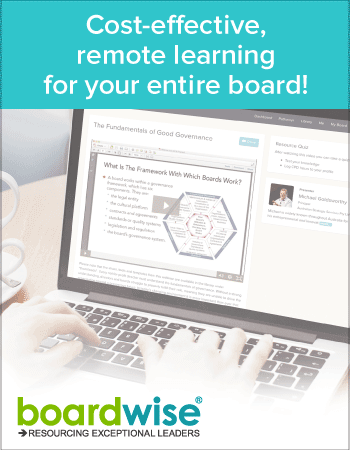finance
Financial Metrics: A Guide for NFP Boards
Published: August 3, 2018
Read Time: 9 minutes

It’s easy to count how much money you’ve made. It’s not so easy to demonstrate that you really are helping children to reach their full potential, or how effectively you’ve raised awareness of a rare disease. Yet not-for-profit (NFP) organisations are increasingly expected to quantify their achievements – and the directors must ensure they’re measuring the right things.
“The board sets the strategic direction and will want to track the organisation’s progress and achievement of these objectives,” says Andrea Petersen, Managing Director, Not for Profit Accounting Specialists. “The directors usually set key performance indicators (KPIs) for the chief executive officer (CEO), who is tasked with delivering the strategic objectives.”
The focus of the KPIs will change according to the nature of the organisation.
“For the Aged Care industry, the board usually measures EBITDA – Earnings Before Interest, Taxes, Depreciation and Amortisation, staff efficiency, occupancy rate and government supported rate,” says Shan Wu, a member of the CPA Chatswood NFP Discussion Group and a Business Analyst at StewartBrown, which provides professional services to Australia’s not-for-profit and aged care sectors.
NFP financial institutions must also satisfy the requirements of regulators such as the Australian Prudential Regulation Authority (APRA) and Australian Securities and Investments Commission (ASIC).
“In the mutual banking sector, where I’ve chaired audit and remuneration committees, boards spend a lot more time on some of the more detailed financial and risk metrics,” says Andrew Crawford, chairman of the Australian Computer Society NSW and a director of Primary & Community Care Services.
All registered charities must comply with the Australian Charities and Not-for-profits Commission (ACNC) governance standards, and all directors need to be familiar with the key metrics defined by the various Acts associated with different legal forms.
“Organisations registered with the ACNC include companies limited by guarantee, incorporated associations and charities,” says Wu. “There are metrics associated with Commonwealth, State and Territory statutes such as workplace health and safety, privacy legislation and taxation, plus governance and the organisation’s constitution. And there are also those relating to management structure and operational flows.”
Petersen believes that directors should have a clear idea of the political, economic and social factors that have an impact on their organisation, as well as trends and where their particular industry might be heading.
“The strategic plan should take all of these factors into account along with the aspirations and objectives of their particular organisation,” she says.
Key financial metrics
Petersen highlights four key financial metrics that are relevant to all organisations.
-
Net Equity Position – Do the organisation’s assets exceed its liabilities? If liabilities exceed assets the organisation is in a negative equity position which can be an indicator of insolvency or lack of sustainability in the longer term.
-
Liquidity – This is measured by the ratio of current assets against current liabilities and is an indicator of cash flow and the ability of the organisation to meet its short-term obligations.
-
Operating Reserves – The ratio of retained earnings against annual operating expenses is an indicator of how long the organisation could continue to operate in the event that all income streams ceased.
-
Actual versus Budget Comparing actual income and expenditure against budget and identifying significant variances highlights areas of over or under spending, or over or underachieving of income targets.
Crawford stresses the importance of monitoring solvency.
“NFPs don’t have access to debt so you must constantly match your funding to your outgoings,” he says. “This can be especially tricky when you have government funding. If the NFP receives some of its income through annual block funding, or even two and three year grants, it would be prudent to make provisions for all closing costs every year.”
Smaller charities in particular need to keep a close eye on their donor base.
“If donations make up a significant percentage of your revenue you need to know where they’re coming from,” says Crawford. “It’s a concern if you’re heavily dependent on one source. Timing is also important in terms of cash flow. Some smaller charities get a large portion of their funding towards the end of June and have to ensure it covers the whole year.”
Metrics can also be used for marketing purposes and to attract donations from the public.
“The use of statistics can enhance credibility and provide evidence that yours is an organisation worthy of support,” says Petersen. “Impact statements are also being used by NFPs as part of their annual reports to highlight their effectiveness and maintain or enhance their reputation.”
Making informed decisions
Every director must be able to make decisions based on the figures.
“Numbers can alert you to risks and they can also indicate potentials for growth,” says Wu. “If you don’t have a financial background you must learn enough to understand and make use of financial reports.”
There is also a legal precedent.
“The Australian Securities and Investments Commission v Healey, otherwise known as the Centro case, made it clear that directors can’t rely on the expertise of other directors or employees to discharge their duty of care,” says Petersen. “They have a responsibility to ensure they have a sufficient level of financial knowledge and understanding. There are organisations that provide financial training for potential directors – this is one of the services we offer – and we also recommend regular tailored training for all boards.”
Directors who don’t have a financial background should not feel intimidated by those who do.
“You should never be afraid to ask basic questions such as: “Do we have enough capital here?” and “What gives you confidence in those numbers?”” says Crawford. “It’s also very dangerous for any director to think that he or she can wing it. You have to be honest with yourself and be prepared to put in as much work as necessary to do your job effectively.”
Internal controls
The board should feel confident that there are internal controls in place to confirm the accuracy of financial metrics.
“Most NFPs are subject to audit or review but you shouldn’t rely solely on your auditors to identify internal control weaknesses,” says Petersen. “Auditors have a duty to provide an opinion on the financial statements being devoid of material misstatements, not that the internal controls are working effectively. The directors must be aware that this is their responsibility.”
Some organisations are too small for an internal audit.
“In this situation I like to check the calculations carefully myself, particularly where there might be omissions or errors,” says Crawford. “In the past I’ve found errors in the treasurer’s report and that’s a definite red flag.”
A broad sweep of information
Not all metrics are financial.
“Non-financial metrics are qualitative measures used to assess an organisation’s activities, benchmarking the activities against its strategic objectives,” Petersen says. “They generally assess organisational productivity and efficiency by measuring performance against targets. For a housing charity, for example, it might be the number of new clients housed or, for member-based organisations, it might be the number of members retained or the number of new members attracted. A volunteer-based organisation might benchmark the number of volunteer hours donated.”
Some charities are now engaging in external benchmarking.
“This can be a good idea,” says Wu. “NFP boards can gain a better understanding of organisational performance and improve accordingly if they benchmark themselves against similar NFPs.” Crawford agrees, though he likes to include a wider range of organisations.
“When I was working with the University of New South Wales Australian Centre for Accounting Management and Development we brought together different organisations and benchmarked a process, such as fund-raising costs or technology spend,” he says. “This can be very useful.
For example, when I was CEO of StreetWork, a very small organisation, I could benchmark things like outreach and number of clients supported through Juvenile Justice against much larger organisations such as Youth Off The Streets or Youth Reach. We found that, despite economies of scale, bigger doesn’t necessarily mean more efficient. For instance, at the time, StreetWork was performing better than Mission Australia in helping young people to find their first job.”
Drawing on public data
External benchmarking has been more feasible since the ACNC began regulating the charitable sector. “The ACNC has created a publicly-available database of more than 55,000 organisations, all of which have to provide at least some financial information,” says Petersen. “For example, the ACNC’s Annual Information Statement collects financial and other information considered relevant to the regulator’s needs. And the ACNC also issues an annual report, which is now providing meaningful trend analysis. It is easier than ever to search for similar organisation’s financial information and compare it with your own.”
However, the ACNC provides limited information on non-financial metrics.
“Some of these can be found by searching through other publicly-available information but you need to be careful you’re comparing like with like,” says Petersen. “For example, researchers at Queensland University of Technology found that, in 2002, direct labour costs were reported to government funding agencies in 113 different ways.”
The ACNC has also been vocal in supporting the right of donors to have access to every NFP’s operating efficiencies.
“The ACNC provides guidance that administration costs should be 15 per cent or less of the donor dollar, and government tenders have followed suit,” says Crawford. “They want to be able to look through the financials and satisfy themselves that there’s a satisfactory return for the services being delivered, satisfactory risk management and that the administration costs are not excessive. But, while this is important, there is a problem with comparing, say, St Vincent de Paul with smaller organisations that don’t operate as many different services. Some have argued that it’s unfair to look at that metric in isolation.”
Where it isn’t compulsory, many NFPs are reluctant to share information.
“Commercial sensitivity is as much a reality in the not-for-profit sector as the private sector,” says Petersen. “Organisations are generally collaborative in nature but they still compete with each other in a crowded market for government funding and charitable donations. Information that supports their competitive edge may be worth keeping under wraps.”
The bigger picture
While the devil may be in the detail, boards need to keep in mind that metrics can also paint a broader picture.
“You should be able to tell from five or 10 metrics whether you’re on track for your mission,” says Crawford. “That’s what any NFP board wants to know – that we’re achieving our reason for being.”
Further Learning
Financial Reporting to the Board
Distressed Balance Sheets – The Board’s Role
Asset Protection in a Commercial Environment
All Your Eggs in the One Basket? The Importance of Diversifying Income for NFPs
Share this Article
Recommended Reading
Recommended Viewing
Author
-
Author
Freelance Journalist
- About
-
Domini contributes regularly to Company Director, ListedASX and NAB’s online business, health and agriculture magazines and has written about health for publications including My Business magazine, the Sunday Telegraph and Wellbeing. She is also an editor, author and speaker.
Found this article useful or informative?
Join 5,000+ not-for-profit & for-purpose directors receiving the latest insights on governance and leadership.
Receive a free e-book on improving your board decisions when you subscribe.
Unsubscribe anytime. We care about your privacy - read our Privacy Policy .










